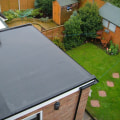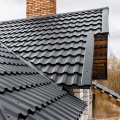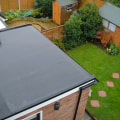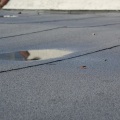Flat roofs are generally versatile, easy to maintain, and more energy efficient than most sloped roofs, so new home builders, in particular, enjoy the lower cost of ownership in the long run. Flat roofs are popular in both apartment buildings and businesses. They are most commonly used in large structures, such as outbuildings. Usually made of synthetic rubber and asphalt, this type of roof isn't really flat, but instead is sloped between ¼ and ½ inch per foot to drain water efficiently.
Are you considering a flat roof for your new building? Before making the final decision, let's take a look at the advantages and disadvantages of this type of roof. Flat roofs aren't the most elegant or stable option for residential or commercial buildings, but they have a lot of benefits. Be a smart shopper and weigh your pros and cons when making the decision to get the best value for your money. An experienced and reliable roofing contractor is the best choice for building a durable and functional roof.
Flat roofs are popular spaces for housing commercial HVAC units. Instead of placing your HVAC on the floor, placing it on the ceiling increases safety and protection against damage. It's not uncommon for people, trees, and nearby appliances to destroy or damage a heating, ventilation, and air conditioning system. Modern flat roofs include high-performance membranes that are extremely durable when it comes to adverse weather conditions.
One of these materials is EPDM, which comprises rubber materials and is environmentally friendly. This roof is waterproof, fire and windproof, and can remain intact for up to 50 years. This means you won't have to worry about your flat roof after a storm, temperature changes, or heavy rain. Another alternative to EPDM is modified bitumen, which was introduced in the early 60s and consists of sheets reinforced with polymers for greater durability.
Therefore, we can safely say that a flat roof will remain in good condition year after year, unlike more fragile roofing materials such as clay and shingles which can crack or break. Flat roofs are often more accessible than sloped roofs. It's easier to climb on them to inspect them. Care and caution must be taken every time a person climbs onto a roof.
Flat roofs are easier to check and much safer. Flat roofs are substantially more stable than sloped roofs when the building is small. In the right environment, they are economical as long as they are properly maintained. Because flat roofs are faster to install, the wait to move is shorter.
If repairs or replacements are needed in the future, reroofing is relatively simple and quick. In addition to low maintenance, flat roofs offer a high return on investment. The practical importance of this lies in the long-term financial benefits it provides. Flat roofs are often more affordable to install compared to pitched roofs as they require fewer materials and less labor.
This initial cost savings is a significant advantage for homeowners looking to maximize their profits. In addition, flat roofs offer additional usable space. They can be transformed into rooftop gardens, recreational areas, or even solar panel installations. This versatility not only increases the value of the property but also provides potential opportunities for energy savings and environmental sustainability.
Overall, flat roofs present a practical and economically rewarding option for homeowners combining low maintenance requirements with a high return on investment. Another advantage of flat roofs is that they can be more energy efficient than sloped roofs. This is due to the type of insulation used. Sloped roofs generally use fiberglass insulation which can be less effective than the spray foam insulation often used on flat roofs.
Spray foam insulation forms a seal around your home preventing heat from escaping in winter and keeping you cool in summer. This can result in significant savings on your energy bills. In warmer climates that experience extended periods of sun exposure an energy-saving white roof membrane can help the homeowner recover thousands of dollars in energy savings. Now that you know the common advantages and disadvantages of flat roofs it's time to look at some options.
Not only do these flat roof extensions expand a property's usable square footage they also improve the overall living experience by providing a private oasis amidst the hustle and bustle of urban life. However this is not a big problem if the flat roof is installed in the garage or shed since you will not spend much time in the outbuilding or extension. While they have some drawbacks there are also several advantages that make flat roofs a great choice for many homeowners. Flat roofs also provide an ideal platform for installing solar panels allowing for green energy generation and potential cost savings on electricity bills.
Regular inspections and maintenance are also critical to identify and address any potential problems before they become serious ensuring that the flat roof continues to perform optimally over time. With space increasingly limited in cities flat roofs provide efficient use of available area. There are some homeowners who use flat roofs for years and there are some homeowners who realize that it's not right for them. In addition to proper planning and materials specialized labor is essential for installing a flat roof.
Flat roofs offer several advantages that make them a popular choice for residential and commercial buildings. Unlike pitched roofs flat roofs do not have complex designs or multiple angles which significantly reduces the chance of debris accumulation and damage due to their low-slope design flat roofs can be easily accessed for inspection repair and cleaning.



